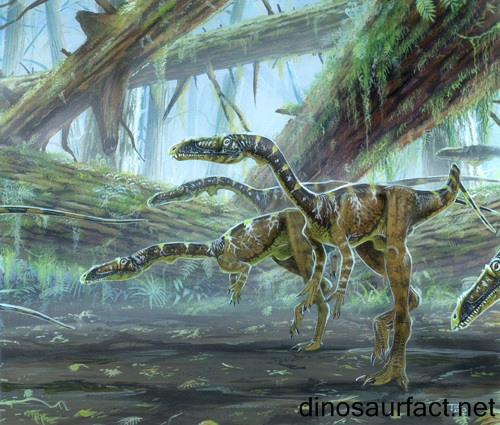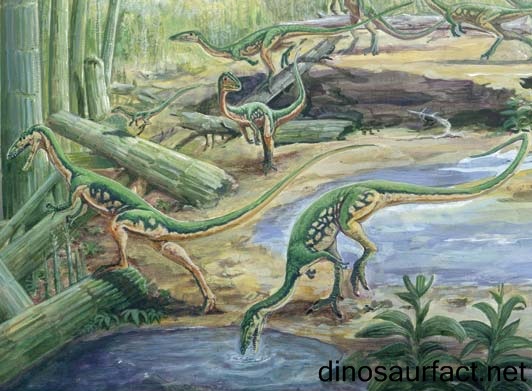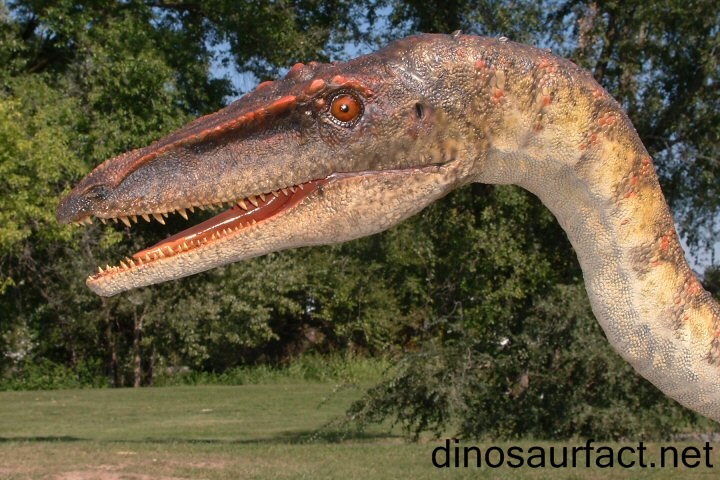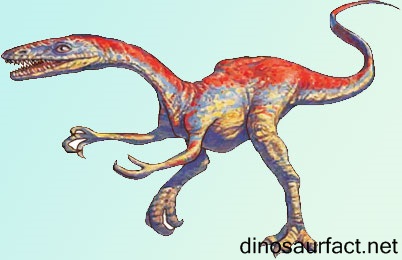 Click to visit the previous dinosaur bio
Click to visit the previous dinosaur bio
 |
|
 |
|
Kingdom: Animalia
Superorder: Dinosauria
Order: Theropoda
Family: Coelophysidae
Genus: Coelophysis
 |
|
 |
|
 |
|

The Coelophysis (scientific name C. Bauri); a short, slender, flesh-eating dinosaur was a bipedal (i.e. it used to walk on two legs) theropod that lived approximately 203-196 million years ago. The name Coelophysis means “hollow bones” (Greek), owing to the bone cavities that is a characteristic of this species. Evidence suggests that these dinosaurs lived during the Late Triassic period in the continent of Northern America. It is one of the earliest dinosaurs according to data obtained from fossil dating. The Coelophysis is also called Longosaurus or Rioarribasaurus. Fossils have been found worldwide in Late Triassic and Early Jurassic formations.
Discovery of the Coelophysis fossils
Edward Drinker Pope, an American paleontologist and anatomist was the first to isolate the Coelophysis dinosaur from the Coelurus genus in 1889. David Baldwin had found the first remains of the fossil in the Chinle formation of New Mexico. A mass grave of fossils was then found in 1947 by George Whitaker at the Ghost Ranch, which is close to the original site of discovery. The fossils found at this site, were composed of many well-preserved fossils.
A good explanation for so many fossils at a particular site suggests the death of a pack, due to flash floods or any such natural calamity. The Coelophysis is the logo of the New Mexico Museum of Natural History. Fossils of this dinosaur were also found at the Petrified Forest Member of the Chinle Formation.
The Chinle Formation and Ghost Ranch
The Chinle Formation is a part of the Colorado plateau and the Interior Plains. It is an upper Triassic continental geological formation in the southwestern region of North America.
The Ghost Ranch was once a part of the Chinle formation. It is located in New Mexico, United States in the continent of Northern America. Around 200 million years ago, this site was located around the equator and thus had a more tropical climate. The Ghost Ranch is rich in dinosaur fossils, especially those belonging to the Triassic period. Other than the fossil graveyard of Coelophysis fossils, fossil remains of other dinosaurs were found at the site. Some of these are Dromomeron romeri, a basal dinosauromorph and Daemonosaurus chauliodus, which is a basal theropod.
Physical features of the Coelophysis
Based on the experiments conducted on the complete fossils found on excavation, scientists have come to the following conclusions about Coelophysis:
Fossils suggest that the Coelophysis dinosaur was approximately 3 meters (9.8 feet) in height and more than a meter tall up to the waist. It could run on two legs and was supposedly fast and agile. It was more advanced than other early theropod dinosaurs.
The bone-structure connecting the upper limb to the axial skeleton has a furcula or wishbone, but it had a weak bone structure. The head of the Coelophysis is slender, long and narrow and is approximately 0.9 feet large.t also has four digits on each hand, out of which three are functional and the fourth is embedded in the skin.
The long snout with cavities helped greatly reduce skull weight. The eyes were forward facing and had excellent depth perception. It is also believed that these dinosaurs had stereoscopic vision, comparable to that of eagles and vultures and was better than most modern day reptiles. The pupils were rather round than split which suggests poor night vision, although some data suggests the Coelophysis was a night predator.
Low, Horizontally placed scaly ridges were present on the dorsal margin of the nasal and lacrimal bones. The dinosaur had narrow hips and feet and forelimbs that were adapted for grasping. The narrow feet had open acetabulum and straight ankle hinge and ended in a three-toed foot with a raised hallux.
The tail had an unusual structure that prevented it from moving up and down, thus improving balance and stability. The teeth were sharp, recurved and blade-like, apt for preying upon animals smaller than itself. The differences between the male and females of the species are considerably significant. This trait is known as sexual dimorphism.
- The gracial or female form of the dinosaur has a longer skull and neck with shorter forelimbs with fused neural spines.
- The robust or male form has a shorter skull and neck than its gracial counterpart with longer forelimbs and unfused neural spines.
The robust form specimens are AMBH 7224 and NMMNH P 42200 while the female form specimen is AMNH 7223.
The physical features of the Coelophysis Bauri are identical to Coelophysis rhodesiensis. The dinosaur also has features corresponding to the genus Coelurus, due to which it was wrongly placed in the same.
About the Coelophysis
The Coelophysis were typical predators of the Late Triassic period, preying on the animals smaller than themselves. Claims of the Coelophysis being cannibalistic i.e. eating its own kind have been refuted. There were 26 teeth on the upper jaw and 27 teeth on the lower jaw of the dinosaur. Using data gathered from its femur, paleontologist Rinehart in 2009 established that C. Bauri juveniles grew and attained sexual maturity rapidly. Four distinct stages of development were identified.
The Coelophysis dinosaur is amongst the more popular dinosaurs, being discovered over a hundred years ago. Graphic representations of this dinosaur can be found in abundance. Even in literature, the Coelophysis dinosaur has several mentions. It was also the second dinosaur to go into space. A skull from Carnegie museum of Natural History was sent with the Space Shuttle Endeavor in 1998 and taken into space station Mir before being returned to earth.
Since a lot of data about the Coelophysis Bauri is available, a lot can be ascertained about this species. This data will also be instrumental in studying closely related but lesser known species like the Camposaurus fossils of which are rare and difficult to study. A lot remains to be known about this dinosaur, and about the exact reason for its disappearance from earth. Even so, the mass grave found at the excavation sites provides some insight into the sudden disaster that caused the extinction of this genus or the whole species of dinosaurs.
Index
Extinct Profiles
 Triassic Dinosaurs
Triassic Dinosaurs Jurassic Dinosaurs
Jurassic Dinosaurs Cretaceous Dinosaurs
Cretaceous Dinosaurs Pterosaurs
Pterosaurs Marine Reptiles
Marine Reptiles Dinosaur Extinction
Dinosaur Extinction